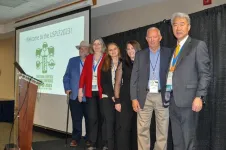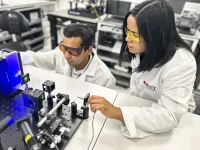(Press-News.org) An international team led by Stefan Pelletier, a Ph.D. student at Université de Montréal's Trottier Institute for Research on Exoplanets announced today having made a detailed study of the extremely hot giant exoplanet WASP-76 b.
Using the MAROON-X instrument on the Gemini-North Telescope, the team was able to identify and measure the abundance of 11 chemical elements in the atmosphere of the planet.
Those include rock-forming elements whose abundances are not even known for giant planets in the Solar System such as Jupiter or Saturn. The team's study is published in the journal Nature.
"Truly rare are the times when an exoplanet hundreds of light years away can teach us something that would otherwise likely be impossible to know about our own Solar System," said Pelletier. "This is the case with this study."
A big, hot, strange world
WASP-76 b is a strange world. It reaches extreme temperatures because it is very close to its parent star, a massive star 634 light-years away in the constellation of Pisces: approximately 12 times closer than Mercury is to the Sun. With a mass similar to that of Jupiter, but almost six times bigger by volume, it is quite "puffy".
Since its discovery by the Wide Angle Search for Planets (WASP) program in 2013, many teams have studied it and identified various elements in its atmosphere. Notably, in a study also published in Nature in March 2020, a team found an iron signature and hypothesised that there could be iron rain on the planet.
Aware of these studies, Pelletier became motivated to obtain new, independent observations of WASP-76 b using the MAROON-X high-resolution optical spectrograph on the Gemini-North 8-metre Telescope in Hawai’i, part of the International Gemini Observatory, operated by NSF’s NOIRLab.
“We recognized that the powerful new MAROON-X spectrograph would enable us to study the chemical composition of WASP-76 b with a level of detail unprecedented for any giant planet,” says UdeM astronomy professor Björn Benneke, co-author of the study and Stefan Pelletier’s PhD research supervisor.
A composition similar to the Sun's
Within the Sun, the abundances of almost all elements in the periodic table are known with great accuracy. In the giant planets in our Solar System, however, that's true for only a handful of elements, whose compositions remain poorly constrained. And this has hampered understanding of the mechanisms governing the formation of these planets.
As it is so close to its star, WASP-76 b has a temperature well above 2000°C. At these degrees, many elements that would normally form rocks here on Earth (like magnesium and iron) are vaporised and present in gaseous form in the upper atmosphere. Studying this peculiar planet enables unprecedented insight into the presence and abundance of rock-forming elements in giant planets, since in colder giant planets like Jupiter these elements are lower in the atmosphere and impossible to detect.
The abundance of many elements measured by Pelletier and his team in the exoplanet's atmosphere – such as manganese, chromium, magnesium, vanadium, barium and calcium – matches those of its host star as well as of our own Sun very closely.
These abundances are not random: they are the direct product of the Big Bang, followed by billions of years of stellar nucleosynthesis, so scientists measure roughly the same composition in all stars. It is, however, different from the composition of rocky planets like Earth, which are formed in a more complex manner.
The results of this new study indicate that giant planets could maintain an overall composition that reflects that of the protoplanetary disc from which they formed.
Depletion of other elements very interesting
However, other elements were depleted in the planet compared to the star – a result Pelletier found particularly interesting.
“These elements that appear to be missing in WASP-76 b’s atmosphere are precisely those that require higher temperatures to vaporise, like titanium and aluminium, ” he said. “Meanwhile, the ones that matched our predictions, like manganese, vanadium, or calcium, all vaporise at slightly lower temperatures.”
The discovery team's interpretation is that the observed composition of the upper atmospheres of giant planets can be extremely sensitive to temperature. Depending on an element’s temperature of condensation, it will be in gas form and present in the upper part of the atmosphere, or condense into liquid form where it will sink to deeper layers. When in gas form, it plays an important role in absorbing light and can be seen in astronomers' observations. When condensed, it cannot be detected by astronomers and becomes completely absent from their observations.
“If confirmed, this finding would mean that two giant exoplanets that have slightly different temperatures from one another could have very different atmospheres, “ said Pelletier. “Kind of like two pots of water, one at -1°C that is frozen, and one that is at +1°C that is liquid. For example, calcium is observed on WASP-76 b, but it may not be on a slightly colder planet.”
First detection of vanadium oxide
Another interesting finding by Pelletier's team is the detection of a molecule called vanadium oxide. This is the first time it has been unambiguously detected on an exoplanet, and is of great interest to astronomers because they know it can have a big impact on hot giant planets.
“This molecule plays a similar role to ozone in Earth's atmosphere: it is extremely efficient at heating up the upper atmosphere," explained Pelletier. "This causes the temperatures to increase as a function of altitude, instead of decreasing as is typically seen on colder planets."
One element, nickel, is clearly more abundant in the exoplanet's atmosphere than what the astronomers were expecting. Many hypotheses could explain that; one is that WASP-76 b could have accreted material from a planet similar to Mercury. In our Solar System, the small rocky planet is enriched with metals like nickel because of how it was formed.
Pelletier's team also found that the asymmetry in iron absorption between the east and west hemispheres of WASP-76 b reported in previous studies is similarly present for many other elements. This means the underlying phenomenon causing this is thus probably a global process such as a difference in temperature or clouds being present on one side of the planet but not the other, rather than being the result of condensation into liquid form as was previously suggested.
Confirming and leveraging lessons learned
Pelletier and his team are very keen to learn more about this exoplanet and other ultra-hot giant planets, in part to confirm their hypothesis about the vastly different atmospheres that could prevail on planets differing slightly in temperature.
They also hope other researchers will leverage what they learned from this giant exoplanet and apply it to better our understanding of our own Solar System planets and how they came to be.
"Generations of researchers have used Jupiter, Saturn, Uranus, and Neptune’s measured abundances for hydrogen and helium to benchmark formation theories of gaseous planets," said Benneke. "Likewise, the measurements of heavier elements such as calcium or magnesium on WASP-76 b will help further understanding the formation of gaseous planets.
About this study
“Vanadium oxide and a sharp onset of cold-trapping on a giant exoplanet,” by Stefan Pelletier et al., was published June 14, 2023 in Nature. In addition to Pelletier and Björn Benneke, the team also includes: Luc Bazinet and Olivia Lim, two graduate students at Université de Montréal's Trottier Institute for Research on Exoplanets (iREx); Mohamad Ali-Dib, a former Trottier postdoctoral fellow at iREx, now at NYU Abu Dhabi; and 13 other co-authors from Canada, the United Arab Emirates, Sweden, France, the United Kingdom, the United States, Italy, the Netherlands and Germany.
END
A scorching-hot exoplanet scrutinized by UdeM astronomers
2023-06-14
ELSE PRESS RELEASES FROM THIS DATE:
A growing number of producers and industries interested in precision livestock farming
2023-06-14
Some of the world’s best minds that are focused on profitable and sustainable livestock production attended and presented at the recent Second U.S. Precision Livestock Farming Conference. Hosted by University of Tennessee AgResearch, the May 21-24 event at the UT Conference Center in Knoxville attracted 219 attendees representing 22 countries and 32 U.S. states. Participants included academics, representatives of government agencies and allied industries as well as producers. The conference had a central theme of “Field Application of PLF Technologies” and academic presentations along with two industry and producer panels included interactive dialogues among the attendees ...
It takes a village: Study shows community is key to a sustained passion for science among adolescents
2023-06-14
The results of a yearlong science program show that one of the best ways to instill a lasting interest in science among children is to engage them alongside their family members. This finding runs counter to the current framework, in which children attend science-related summer camps and after-school programs apart from their families, diminishing the long-term potential of what they learn.
“We wanted to see if we could support families as a whole, as opposed to giving a student a really amazing one-off experience and sending them ...
Racial disparities found in one of first studies of pharmacological treatment of insomnia
2023-06-14
INDIANAPOLIS — In one of the first studies to investigate racial disparities in the pharmacologic treatment of insomnia, researchers from Regenstrief Institute and Indiana University report that patients belonging to racial minority groups were significantly less likely to be prescribed medication following diagnosis of insomnia than White patients.
The study found that Black patients were much less likely to have been prescribed an FDA-approved insomnia medication at any time post diagnosis than White patients. Other non-White individuals were significantly less likely to be prescribed an FDA-approved medication two, three, and four years after insomnia diagnosis ...
New York Academy of Sciences, Leon Levy Foundation name first 10 Leon Levy Scholars in Neuroscience
2023-06-14
New York, NY, June 14, 2023 — The New York Academy of Sciences and the Leon Levy Foundation announced today the first cohort of Leon Levy Scholars in Neuroscience; a continuation of an earlier fellowship program started by the Foundation in 2009 that has supported 160 fellows in neuroscience.
This highly regarded postdoctoral program supports exceptional young researchers across the five boroughs of New York City as they pursue innovative investigations in neuroscience and advance in their careers toward becoming independent principal investigators. Designed to broaden the field and to support researchers who might otherwise not ...
Cancer researchers focused on bringing new discoveries to patients get two-year funding awards
2023-06-14
June 14, 2023, TORONTO — Funding announced today by the Ontario Institute for Cancer Research (OICR) will help six Ontario-based research teams pursue their ultimate goal of improving the lives of people with cancer.
Funding comes through OICR’s Innovation to Implementation (I2I) program, which aims to help ensure new discoveries about preventing, diagnosing and treating cancer are adopted into healthcare policy and clinical practice.
“Every cancer researcher wants their work to have ...
Dr. Jonathan Weinsaft named chief of the Greenberg Division of Cardiology at Weill Cornell Medicine and NewYork-Presbyterian/Weill Cornell Medical Center
2023-06-14
NEW YORK (June 14, 2023)— Dr. Jonathan Weinsaft, an esteemed physician-scientist who focuses on clinical research and cardiovascular imaging, has been appointed chief of the Greenberg Division of Cardiology at Weill Cornell Medicine and NewYork-Presbyterian/Weill Cornell Medical Center, effective July 1.
The Greenberg Division of Cardiology, housed within the Weill Department of Medicine, is dedicated to diagnosing and treating patients with disorders of the heart and blood vessels that comprise the cardiovascular system.
In his new role, Dr. Weinsaft will further strengthen the division as a leader in scientific and technological ...
New diagnostic finds intact sperm in infertile men
2023-06-14
In a recent study, researchers created a diagnostic test to identify functional sperm in infertile men that could change the treatment of male infertility and assisted reproductive technology.
“Male infertility is a recognized issue and deserves scientific and clinical attention,” said Andrei Drabovich, an assistant professor of laboratory medicine and pathology at the University of Alberta and corresponding author of the Molecular & Cellular Proteomics study.
One in every six couples trying to conceive experience infertility issues. In fact, about 10% of men in the United States are infertile. The most ...
A novel technique to observe colloidal particle degradation in real time
2023-06-14
In the early 2000s, scientists from the UK made a worrisome discovery that the oceans are teeming with small particles of plastic (less than one millimeter in length) due to the continuous degradation of plastic waste. These microscopic particles of plastic have become a major environmental concern. Scientists classify these small particles as either microplastics or nanoplastics based on their size; the latter term is used exclusively for particles smaller than one micrometer.
These particles easily get embedded into the bodies of marine and freshwater animals, ...
Tiny device mimics human vision and memory abilities
2023-06-14
Researchers have created a small device that ‘sees’ and creates memories in a similar way to humans, in a promising step towards one day having applications that can make rapid, complex decisions such as in self-driving cars.
The neuromorphic invention is a single chip enabled by a sensing element, doped indium oxide, that’s thousands of times thinner than a human hair and requires no external parts to operate.
RMIT University engineers in Australia led the work, with contributions from researchers at Deakin University and the University of Melbourne.
The team’s research demonstrates a working device that captures, processes and stores visual ...
Solar cells can, finally, stand the heat
2023-06-14
SDE BOKER, Israel, June 14, 2023 – Photovoltaic technology is indispensable for our ability to mitigate climate change. Nonetheless, more than 70% of the energy made available to us by the sun is wasted in conventional photovoltaic cells. There is little hope for sustainable technological advancement without addressing this issue.
The operational temperature is a critical factor in a solar cell's ability to convert sunlight to free energy. Accordingly, much research has been directed toward understanding the temperature effects in the efficiency of photovoltaic solar cells. Surprisingly, ...








